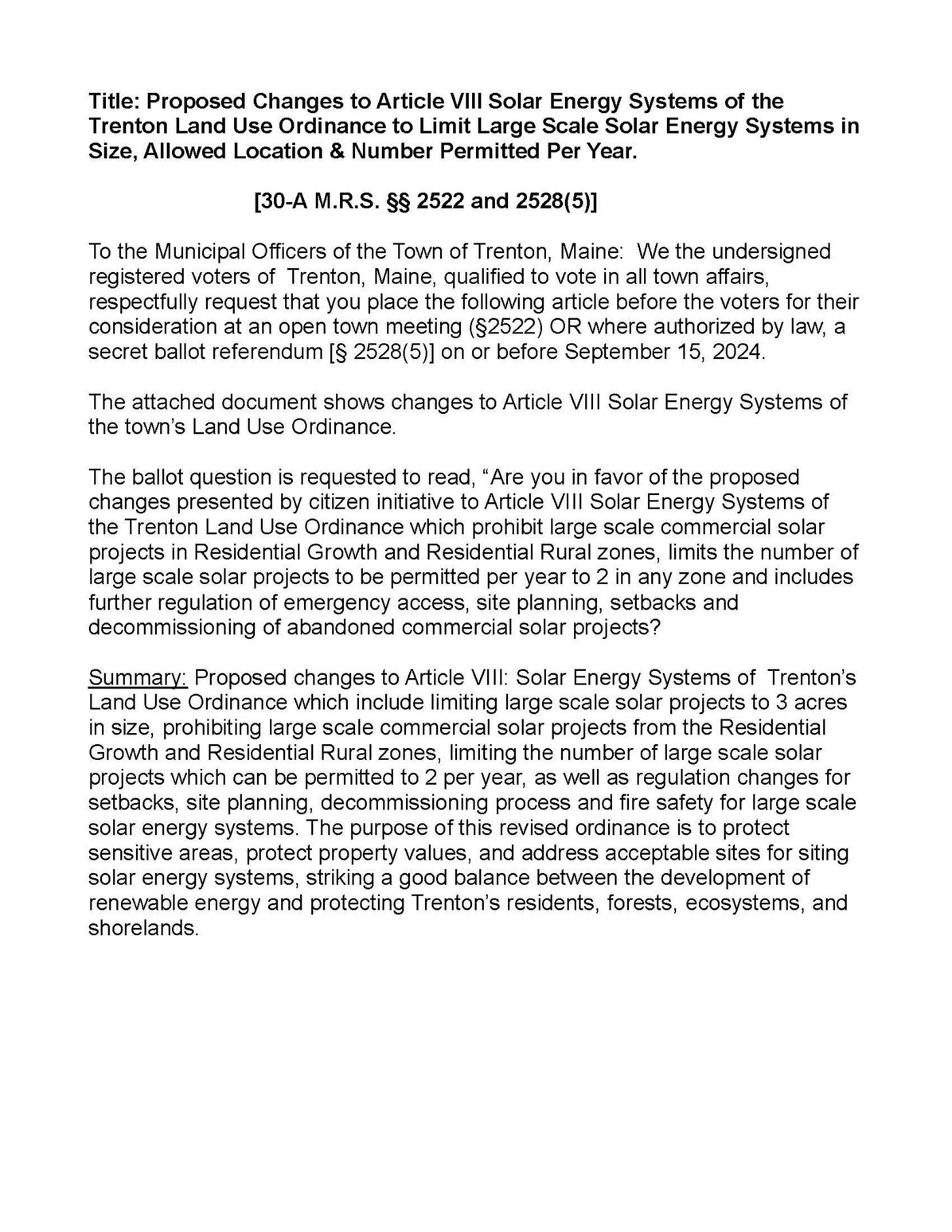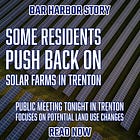"The Battle For Trenton"
Big Solar Decisions in Trenton and Bar Harbor and Trenton Budget and Elections This Week
TRENTON—Solar energy. Solar arrays. Solar energy systems.
In very different ways and in very different manners, both Bar Harbor’s Town Council and the voters of Trenton will have a chance to make some decisions on the development of solar energy projects in their towns this week.
Bar Harbor’s Town Council will potentially make a decision about the Higgins’ Pit solar array project in its town. That project was approved by voters in 2022, but since then, costs have risen beyond initial projections, prompting concerns for some. Because of the site of the town-owned property, wetland remediation would have to be done, a road would have to be built, and the project itself has been downsized. Proponents say that even with those changes, the project is worth the carbon-offsets and climate-positive impacts of the project. The town has already made one payment on the bond, which was sold in August 2023. The town procured a $4.35 million bond to support the project.
The parcel is 40-acres, owned by the town since 1972, and located in Salisbury Cove. A feasibility study at the site occurred in April 2021. Only a portion of the lot is developable because of the features of the site, wetlands, and brownfields. It had been a dumping area for waste from construction and sludge and hasn’t been used much since the 1970s.
TRENTON
In Trenton, voters will decide whether to allow changes to how solar energy systems are developed. Those changes would go into the town’s Land Use Ordinance.
ARTICLE 3
After a petition request of over 100 Trenton voters, the town has a moratorium on medium- and large-scale commercial solar development.
The moratorium also came after a developer proposed creating a 70-megawatt solar farm near the town’s industrial park. Approximately 300 acres of land would have been cleared. The Ellsworth American reported that the Maryland-based company also discussed a potential tax increment financing (TIF) agreement for the project. TIFs enable a town or city to keep property tax revenue outside the state’s revenue sharing formula used for state’s education funding. The town can then use that money for credit enhancements with the property owner instead. It’s a kind of tax break meant to incentivize development.
It’s not the first moratorium Trenton has had as it has tried to regulate solar energy projects. An earlier moratorium occurred in 2020. That moratorium allowed the town to create regulations that define projects as small, medium, or large.
The Planning Board has revised the town’s current solar ordinance, hoping to address a citizen push toward limiting commercial solar developments or solar farms.
Article 3 is on the written ballot. It asks voters to approve (or not) the Planning Board’s suggested revisions of Article III: Zoning and Article VIII: Solar Energy Systems of the land use ordinance.
The Planning Board has recommended a yes vote. However, some residents worry about the changes.
Neighbors Against More Large-scale Solar Farms, the Trenton citizens group watching this issue, recommends a no vote on Article 3. Much of the opposition focuses on worries that the changes do not do enough to prevent large-scale, commercial solar farms. Worries also include fire access and the need for special equipment for fire response to the area, habitat displacement, and deforestation, changing the character of Trenton’s residential zones by allowing commercial large-scale solar farms, and what would happen after the lifespan of the solar farm (25-30 years).
Three solar projects in Trenton have already received approval before the moratorium. Those projects total approximately 60 acres.
According to Christina Heiniger, “Neighbors Against More Large-scale Solar Farms is currently circulating a petition in Trenton to get a different version that we wrote of Article VIII of our LUO on another ballot (not the May 20 ballot) before our solar moratorium expires on September 29. We are offering Trenton voters a viable and carefully researched and written alternative to what the planning board is offering. If voters reject the planning board's proposed revisions on May 20, there’s another option.”
According to Heiniger,
“Article III of our Land Use Ordinance is the Article that deals with Land Use District Requirements. Article III is—as drafted & proposed on the ballot—being revised in a way that will allow large commercial solar farms of up to 30 acres in two residential zones. These zones (districts) are Residential Growth and Residential Rural. The definitions of these zones are being changed in order to explicitly allow this. Many residents feel that commercial solar developments of any size should not be in residential districts and very limited in our commercial areas. Trenton currently already has three solar farms permitted or under construction that total about 60 acres.
“The definition of Residential Growth (the turquoise on the map) is reworded in the draft away from a district whose use is ‘compatible with traditional residential neighborhoods’ to a zone which is ‘compatible with accessible infrastructure and to encourage passive development of interior land...including but not restricted to farming, utilities, and recreation.’
“The Residential Rural district (the light green on the map) is being reworded away from being a ‘primarily rural setting’ and one whose uses are ‘compatible with traditional rural neighborhoods’ to ‘compatible with accessible infrastructure and to encourage passive development of interior land...including but not restricted to farming, utilities, and recreation’.
“Many Trenton residents see these as big wording changes, that are somewhat vague, that could or would dramatically alter those districts for those of us living there, not just by allowing solar farms of up to 30 acres, but perhaps also allowing other kinds of businesses and activities that you might not want going on right next door. Changing the wording of these two districts is a slippery slope and not a good precedent to set.”
In a March 2024 Ellsworth American article, Rebecca Alley quoted Planning Board Chair Mark Remick as saying of the changes, “This is not an additional set of rules or allowances. This restricts what was already on the books.”
However, opponents emphasize that the 30-acre cap on project size does not restrict enough, nor are the buffers meant to decrease project visibility. In one letter to the Ellsworth American, Michael Updegraff, called it a battle for Trenton, writing, “There is a battle underway in Trenton. On one hand are the developers, out-of-state corporations grabbing federal green-energy subsidies and leasing large tracts of land to build solar arrays. And while there may be an argument made for such development in some places, our town is fixed on a narrow peninsula that contains ideal habitat for beaver, moose, deer, bear, otters, eagles, and foxes.”
Trenton is also not the only town facing “push back” against solar projects, which began sprouting up after being incentivized by 2019 Maine law, LD 1711. The law is meant to help the state meet a clean and renewable energy goal of 80% by 2030.
Since 2020, multiple Maine towns and cities (including Ellsworth) have had moratoriums on commercial solar energy projects.
In a December 2023, Bangor Daily News article, Lori Valigra writes,
“Maine has 7,317 solar installations with a total of 948 megawatts of power, according to the Solar Energy Industries Association. By 2030, the U.S. could begin piling up millions of metric tons of waste from decommissioned solar models, according to the National Renewable Energy Laboratory.
“Other Maine towns have acted similarly. Glenburn in 2022 voted to ban solar arrays larger than 15,000 square feet. Corinth issued a temporary ban in March on commercial solar developments that gave it 180 days to draft rules and regulations for future commercial projects. In August 2023 Brewer city councilors unanimously approved a similar moratorium to give them time to review and revise local rules for solar developments. Troy in early December became the latest Maine town to enact an ordinance regulating large-scale solar and wind energy projects, prompted by the proposed LS Power, Long Road and King Pine transmission and wind mega-project in southern Aroostook County.”
ARTICLE FOUR
Article 4 on the ballot regards state-mandated changes to shoreland zoning that the planning board wrote into Trenton’s Land Use Ordinance.
SELECT BOARD AND SCHOOL COMMITTEE ELECTIONS
Two issues as well as the seats for Select Board and School Committee will be on the ballot Monday, May 20. Polls are open from 2 to 6 p.m. at the town office.
Incumbents John Bennett and Charles Farley are both looking to hold onto their Select Board seats. Carol Perrault is hoping to grab one of those two seats. They are elected for three-year terms.
Two School Committee seats are on the ballot. Committee Chair Aaron Brown is running as is Stefanie Shattenberg. Current member Gary Burr is not running for reelection.
TOWN MEETING TIME
Though the election and articles three and four occur via ballot on Monday, Trenton’s Open Town Meeting is May 21 at the Trenton Elementary School at 6 P.M. Voters will approve (or not) budget numbers and other articles.
LINKS TO LEARN MORE
Rebecca Alley’s Ellsworth American article.
For questions about the Solid Waste issues, you can contact the committee at TrentonSWC@yahoo.com
Proposed Changes to LUO and Shoreland Zoning
Proposed changes to the LUO, Sections III and VIII, and to the Shoreland Zoning Ordinance, Section 14 and Section 17.
Thanks for reading this article! All our posts are free because we want to make sure that everyone always has access to their local news, so feel free to share it if you want.
If you’d like to donate to help support us, you can, but no pressure! Just click here.











